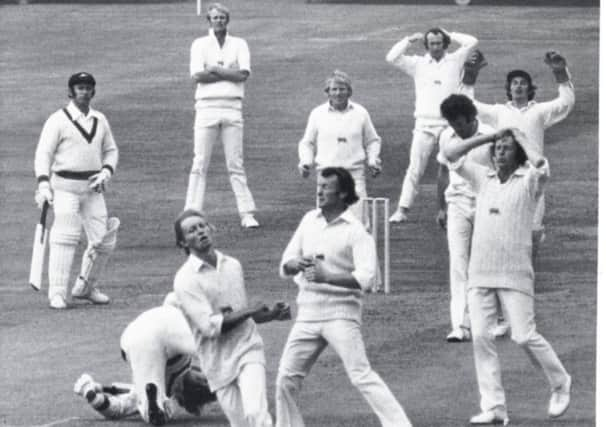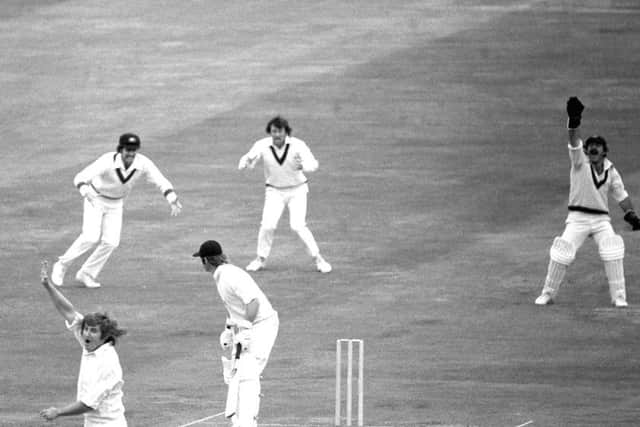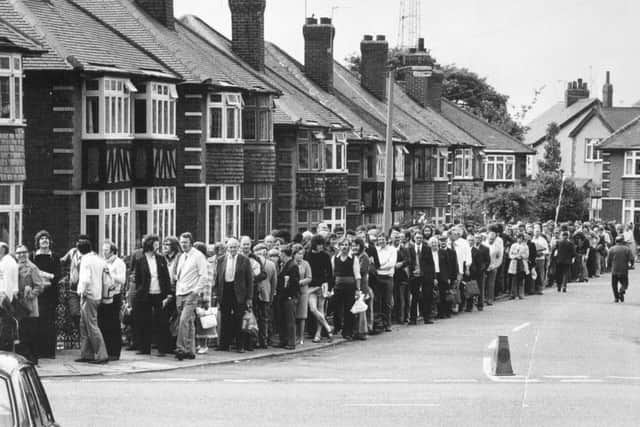Bygones: When 1975 Headingley thriller helped establish cricket’s World Cup


It is the first of 48 games before the competition finishes at Lord’s on July 14.
It is all in stark contrast to the first World Cup in 1975 when there were just 15 matches and five days’ playing time.
Advertisement
Hide AdAdvertisement
Hide AdOne-day cricket was still in its infancy, and the West Indies won a comparatively low-key event, beating Australia by 17 runs in the final at Lord’s.


Three of the 15 games staged in that inaugural World Cup took place at Headingley, with fixtures also held at Edgbaston, Old Trafford, Trent Bridge and The Oval, in addition to Lord’s.
The Leeds venue hosted the group matches between Australia and Pakistan and India versus East Africa, followed by the semi-final between England and Australia.
This year, Headingley – or Emerald Headingley as it is now called – stages four fixtures, all of which are in the group phase.
Advertisement
Hide AdAdvertisement
Hide AdThey are England versus Sri Lanka (June 21), Pakistan versus Afghanistan (June 29), Afghanistan versus the West Indies (July 4) and Sri Lanka versus India (July 6).


Forty years ago, despite the low-key nature of that initial World Cup interest was high at Headingley for what was then perceived as a novelty event, fans flocking to the first game between Australia and Pakistan.
“For the first time since 1966,” reported Wisden Cricketers’ Almanack, “gates were closed and for the 22,000 crowd there was an excellent day of cricket”, Australia winning by 73 runs.
In what was just the 21st one-day international played, Dennis Lillee, the great Australian fast bowler, became the first man to take five wickets in an ODI, returning figures of 5-34 from 12 overs to help dismiss Pakistan for 205 in reply to 278-7.
Advertisement
Hide AdAdvertisement
Hide AdAustralia’s innings was spread over 60 overs, which was then the duration of World Cup games, their run-rate of 4.63 per over positively pedestrian by modern standards.
“The Australian batsmen scored without taking risks,” said Wisden, almost admiringly, Ross Edwards top-scoring with 80 not out. The Chappell brothers Ian and Greg “kept the ball on the ground”.
“Australia’s was quite obviously a winning score,” the almanack added, whereas nowadays a target of 279 would be laughed out of town.
“Banner waving Pakistan supporters danced in delight” as Majid Khan and captain Asif Iqbal made half-centuries, but Lillee and Australia were comfortable winners.
Advertisement
Hide AdAdvertisement
Hide AdHowever, it was a disappointing day for Lillee’s famous pace-bowling partner Jeff Thomson, whose first over contained five no-balls and whose “loss of rhythm gave cause for concern”.
The second match at Headingley in the 1975 World Cup featured a debut for D Pringle, but it was Don Pringle of East Africa as opposed to his son Derek, the England all-rounder.
Born in Lancashire, Don Pringle had been playing for Kenya, where he was a landscape consultant for many years.
Tragically he died later in 1975, aged 43, when he was killed in a car crash on his way back from a match in Nairobi.
Advertisement
Hide AdAdvertisement
Hide AdThe East Africans (effectively a composite of Kenya, Uganda, Tanzania and Zambia) were no match for the Indians, who hammered them by 10 wickets with 30.1 overs to spare.
East Africa were dismissed for 120 in 55.5 overs, the great left-arm spinner Bishen Bedi recording the extraordinary analysis of 12-8-6-1 before half-centuries from Sunil Gavaskar and Farokh Engineer led India home.
Wisden proclaimed: “East Africa’s batsmen were quite obviously in a class of cricket above them.
“Their batsmen were without the technique necessary to score runs off accurate Test class bowling and the bowlers, performing on a surface which had nothing to offer, had little to give other than all out effort.”
Advertisement
Hide AdAdvertisement
Hide AdIn contrast to the 22,000 crowd for the game between Australia and Pakistan, Wisden noted that “other than Yorkshire members, officials and guests, only 720 people paid for admission”.
The fans were back out in force for the last match at Leeds, however, when Australia beat England by four wickets in an exciting semi-final.
It was a low-scoring contest, England bowled out for just 93 in 36.2 overs as Gary Gilmour, a 23-year-old left-arm swing bowler, took new ODI record figures of 6-14 from 12 overs.
“Gilmour ripped through the England batting,” said Wisden. “Bowling a full length, over the wicket, he not only swung the ball in the heavy atmosphere, but he moved it both ways after pitching.
Advertisement
Hide AdAdvertisement
Hide Ad“Bringing the ball back after pitching on the off stump he had Amiss, Fletcher, Hayes and Knott lbw – Fletcher without playing a shot – and all played back.
“He bowled Wood with a perfect yorker and had Greig caught one-handed by Marsh.”
The pitch was the same one used for the Australia-Pakistan match, but it had been watered and looked green and damp.
It was criticised by England captain Mike Denness and his Australian counterpart Ian Chappell, but paradoxically it helped produce great excitement as Gilmour’s unbeaten 28 then led Australia home after they had slumped to 39-6.
Advertisement
Hide AdAdvertisement
Hide Ad“Gasps, groans, or cheers, followed every ball,” wrote Wisden.
“Snow and Old ripped into the Australian batsmen as dramatically as Gilmour had treated England.
“Then came Gilmour as a batsman. With Walters he shared an unbroken partnership adding 55 vital runs.
“The huge crowd rose to him and the former West Indies captain Jeffrey Stollmeyer had no difficulty in naming him Man of the Match.”
Advertisement
Hide AdAdvertisement
Hide AdIn the other semi-final, played at The Oval on the same day, the West Indies beat New Zealand by five wickets.
Alvin Kallicharran and Gordon Greenidge made half-centuries as they knocked off a target of 159.
Gilmour was up to his tricks again in the final, taking 5-48 from his 12 overs as the West Indies made 291-8 from their 60 overs. One of his victims was captain Clive Lloyd, who top-scored with 102, Rohan Kanhai also registering a fifty.
Ian Chappell top-scored with 62 in Australia’s reply, but, at 8.42pm on the longest day of the year, the West Indies became the first World Cup winners as Australia pulled up narrowly short.
Advertisement
Hide AdAdvertisement
Hide AdAs Chappell would recall: “As the final involved not only the two best sides but also the most aggressive teams, it was important the game was of a high standard.
“The fact that it exceeded all expectations was the moment I thought, ‘The World Cup is here to stay’.”
As winners the West Indies received the princely sum of £4,000.
The following day many of their players turned out for their counties in the John Player League, including Viv Richards for Somerset against Yorkshire at Bradford.
How times have changed.